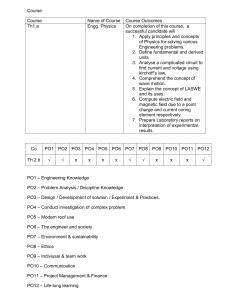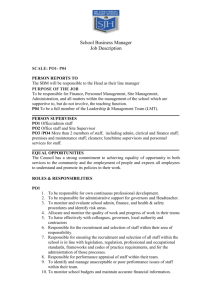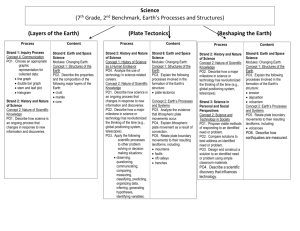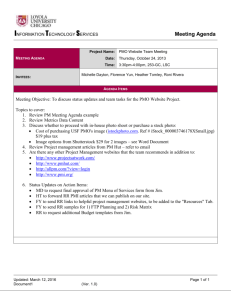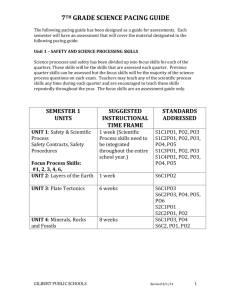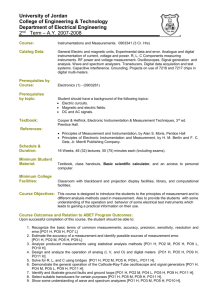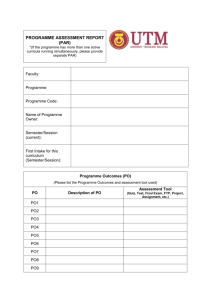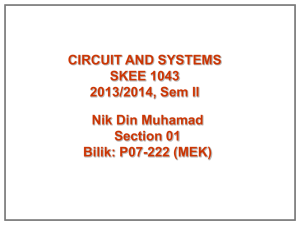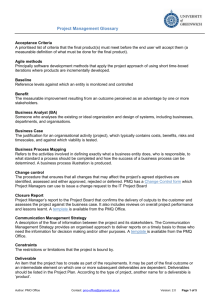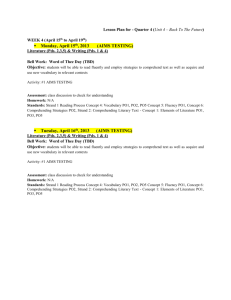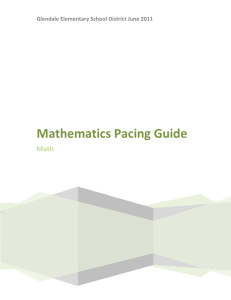Grade 07 Ongoing Arizona State Standards (For use during
advertisement
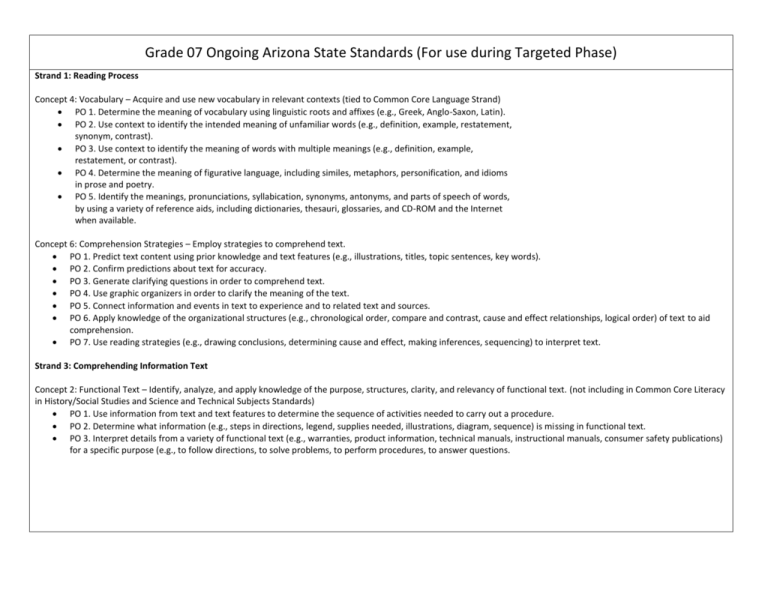
Grade 07 Ongoing Arizona State Standards (For use during Targeted Phase) Strand 1: Reading Process Concept 4: Vocabulary – Acquire and use new vocabulary in relevant contexts (tied to Common Core Language Strand) PO 1. Determine the meaning of vocabulary using linguistic roots and affixes (e.g., Greek, Anglo-Saxon, Latin). PO 2. Use context to identify the intended meaning of unfamiliar words (e.g., definition, example, restatement, synonym, contrast). PO 3. Use context to identify the meaning of words with multiple meanings (e.g., definition, example, restatement, or contrast). PO 4. Determine the meaning of figurative language, including similes, metaphors, personification, and idioms in prose and poetry. PO 5. Identify the meanings, pronunciations, syllabication, synonyms, antonyms, and parts of speech of words, by using a variety of reference aids, including dictionaries, thesauri, glossaries, and CD-ROM and the Internet when available. Concept 6: Comprehension Strategies – Employ strategies to comprehend text. PO 1. Predict text content using prior knowledge and text features (e.g., illustrations, titles, topic sentences, key words). PO 2. Confirm predictions about text for accuracy. PO 3. Generate clarifying questions in order to comprehend text. PO 4. Use graphic organizers in order to clarify the meaning of the text. PO 5. Connect information and events in text to experience and to related text and sources. PO 6. Apply knowledge of the organizational structures (e.g., chronological order, compare and contrast, cause and effect relationships, logical order) of text to aid comprehension. PO 7. Use reading strategies (e.g., drawing conclusions, determining cause and effect, making inferences, sequencing) to interpret text. Strand 3: Comprehending Information Text Concept 2: Functional Text – Identify, analyze, and apply knowledge of the purpose, structures, clarity, and relevancy of functional text. (not including in Common Core Literacy in History/Social Studies and Science and Technical Subjects Standards) PO 1. Use information from text and text features to determine the sequence of activities needed to carry out a procedure. PO 2. Determine what information (e.g., steps in directions, legend, supplies needed, illustrations, diagram, sequence) is missing in functional text. PO 3. Interpret details from a variety of functional text (e.g., warranties, product information, technical manuals, instructional manuals, consumer safety publications) for a specific purpose (e.g., to follow directions, to solve problems, to perform procedures, to answer questions. AZ State Standards Reading For Literature 1 CC.7.RL.1 Cite several pieces of textual evidence to support analysis of what they text says explicitly as well as inferences drawn from the text. S3.C1.PO3 S3.CI.PO10 CC.7.RI.1 Cite several pieces of textual evidence to support analysis of what the text says explicitly as well as inferences drawn from the text. S3.C1.PO3 S3.CI.PO10 CC.7.RL.2 Determine a theme or central idea of a text and analyze its development over the course of the text; provide an objective summary of the text. S2.C1.PO2 CC.7.RI.2 Determine two or more central ideas in a text and analyze their development over the course of the text; provide an objective summary of the text. S3.C1.PO1 S3.C1.PO2 S3.C1.PO11 CC.7.RL.3 Analyze how particular elements of a story or drama interact (e.g., how setting shapes the characters or plot). S2.C1.PO1 S2.C1.PO3 S2.C1.PO5 S3.C1.PO12 CC.7.RL.4 Determine the meaning of words and phrases as they are used in a text, including figurative and connotative meanings; analyze the impact of rhymes and other repetitions of sounds (e.g., alliteration) on a specific verse or stanza of a poem or section of a story or drama. S2.C1.PO6 S2.C1.PO7 S2.C1.PO8 CC.7.RI.4 Determine the meaning of words and phrases as they are used in a text, including figurative, connotative, and technical meanings; analyze the impact of a specific word choice on meaning and tone. CC.7.RI.5 Analyze the structure an author uses to organize a text, including how the major sections contribute to the whole and to the development of the ideas. S3.C1.PO5 S3.C1.PO9 CC.7.RL.6 Analyze how an author develops and contrasts the points of view of different characters or narrators in a text. S2.C1.PO3 S2.C1.PO4 Reading for Information AZ State Standards Quarter AZ State Standards Reading for Information AZ State Standards Quarter Reading For Literature 2 CC.7.RL.1 Cite several pieces of textual evidence to support analysis of what they text says explicitly as well as inferences drawn from the text. S3.C1.PO3 S3.CI.PO10 CC.7.RI.1 Cite several pieces of textual evidence to support analysis of what the text says explicitly as well as inferences drawn from the text. S3.C1.PO3 S3.CI.PO10 CC.7.RL.2 Determine a theme or central idea of a text and analyze its development over the course of the text; provide an objective summary of the text. S2.C1.PO2 CC.7.RI.2 Determine two or more central ideas in a text and analyze their development over the course of the text; provide an objective summary of the text. S3.C1.PO1 S3.C1.PO2 S3.C1.PO11 CC.7.RL.3 Analyze how particular elements of a story or drama interact (e.g., how setting shapes the characters or plot). S2.C1.PO1 S2.C1.PO3 S2.C1.PO5 CC.7.RI.3 Analyze the interactions between individuals, events, and ideas in a text (e.g. how ideas influence individuals or events, or how individuals influence ideas or events). S3.C1.PO9 CC.7.RL.4 Determine the meaning of words and phrases as they are used in a text, including figurative and connotative meanings; analyze the impact of rhymes and other repetitions of sounds (e.g., alliteration) on a specific verse or stanza of a poem or section of a story or drama. S2.C1.PO6 S2.C1.PO7 S2.C1.PO8 CC.7.RI.4 Determine the meaning of words and phrases as they are used in a text, including figurative, connotative, and technical meanings; analyze the impact of a specific word choice on meaning and tone. S3.C1.PO12 CC.7.RL.5 Analyze how a drama’s or poem’s form or structure (e.g., soliloquy, sonnet) contributes to its meaning. S2.C1.PO7 CC.7.RI.5 Analyze the structure an author uses to organize a text, including how the major sections contribute to the whole and to the development of the ideas. S3.C1.PO5 S3.C1.PO9 CC.7.RL.7 Compare and contrast a written story, drama, or poem to its audio, filmed, staged, or multimedia version, analyzing the effects of techniques unique to each medium (e.g., lighting, sound, color, or camera focus and angles in a film). S2.C1.PO1 S2.C1.PO3 S2.C1.PO5 CC.7.RI.6. Determine the author’s point of view or purpose in a text and analyze how the author distinguishes his or her position from that of others. S3.C1.PO4 CC.7.RI.7 Compare and contrast a text to an audio, video, or multimedia version of a text, analyzing each medium’s portrayal of the subject (e.g., how the delivery of a speech affects the impact of the words). S3.C1.PO6 S3.C1.PO7 S3.C1.PO8 AZ State Standards Reading for Information AZ State Standards Quarter Reading For Literature 3 CC.7.RL.1 Cite several pieces of textual evidence to support analysis of what they text says explicitly as well as inferences drawn from the text. S3.C1.PO3 S3.CI.PO10 CC.7.RI.1 Cite several pieces of textual evidence to support analysis of what the text says explicitly as well as inferences drawn from the text. S3.C1.PO3 S3.CI.PO10 CC.7.RL.2 Determine a theme or central idea of a text and analyze its development over the course of the text; provide an objective summary of the text. S2.C1.PO2 CC.7.RI.2 Determine two or more central ideas in a text and analyze their development over the course of the text; provide an objective summary of the text. S3.C1.PO1 S3.C1.PO2 S3.C1.PO11 CC.7.RL.4 Determine the meaning of words and phrases as they are used in a text, including figurative and connotative meanings; analyze the impact of rhymes and other repetitions of sounds (e.g., alliteration) on a specific verse or stanza of a poem or section of a story or drama. S2.C1.PO6 S2.C1.PO7 S2.C1.PO8 CC.7.RI.3 Analyze the interactions between individuals, events, and ideas in a text (e.g. how ideas influence individuals or events, or how individuals influence ideas or events). S3.C1.PO9 CC.7.RL.6 Analyze how an author develops and contrasts the points of view of different characters or narrators in a text. S2.C1.PO3 S2.C1.PO4 CC.7.RI.8 Trace and evaluate the argument and specific claims in a text, assessing whether the reasoning is sound and the evidence is relevant and sufficient to support the claims. S3.C3.PO1 S3.C3.PO2 S3.C3.PO3 CC.7.RL.9 Compare and contrast a fictional portrayal of a time, place, or character and a historical account of the same period as a means of understanding how authors of fiction use or alter history. S2.C1.PO1 S2.C1.PO3 S2.C1.PO5 S2.C2.PO1 S2.C2.PO2 CC.7.RI.9 Analyze how two or more authors writing about the same topic shape their presentations of key information by emphasizing different evidence or advancing different interpretations of facts. S3.C3.PO1 S3.C3.PO2 S3.C3.PO3 AZ State Standards Reading For Literature 4 CC.7.RL.1 Cite several pieces of textual evidence to support analysis of what they text says explicitly as well as inferences drawn from the text. S3.C1.PO3 S3.CI.PO10 CC.7.RI.1 Cite several pieces of textual evidence to support analysis of what the text says explicitly as well as inferences drawn from the text. S3.C1.PO3 S3.CI.PO10 CC.7.RL.2 Determine a theme or central idea of a text and analyze its development over the course of the text; provide an objective summary of the text. S2.C1.PO2 CC.7.RI.2 Determine two or more central ideas in a text and analyze their development over the course of the text; provide an objective summary of the text. S3.C1.PO1 S3.C1.PO2 S3.C1.PO11 CC.7.RL.3 Analyze how particular elements of a story or drama interact (e.g., how setting shapes the characters or plot). S2.C1.PO1 S2.C1.PO3 S2.C1.PO5 CC.7.RI.3 Analyze the interactions between individuals, events, and ideas in a text (e.g. how ideas influence individuals or events, or how individuals influence ideas or events). S3.C1.PO9 CC.7.RL.4 Determine the meaning of words and phrases as they are used in a text, including figurative and connotative meanings; analyze the impact of rhymes and other repetitions of sounds (e.g., alliteration) on a specific verse or stanza of a poem or section of a story or drama. S2.C1.PO6 S2.C1.PO7 S2.C1.PO8 CC.7.RI.4 Determine the meaning of words and phrases as they are used in a text, including figurative, connotative, and technical meanings; analyze the impact of a specific word choice on meaning and tone. S3.C1.PO12 CC.7.RL.5 Analyze how a drama’s or poem’s form or structure (e.g., soliloquy, sonnet) contributes to its meaning. S2.C1.PO7 CC.7.RI.5 Analyze the structure an author uses to organize a text, including how the major sections contribute to the whole and to the development of the ideas. S3.C1.PO5 S3.C1.PO9 CC.7.RL.6 Analyze how an author develops and contrasts the points of view of different characters or narrators in a text. S2.C1.PO3 S2.C1.PO4 CC.7.RI.6. Determine the author’s point of view or purpose in a text and analyze how the author distinguishes his or her position from that of others. S3.C1.PO4 CC.7.RL.7 Compare and contrast a written story, drama, or poem to its audio, filmed, staged, or multimedia version, analyzing the effects of techniques unique to each medium (e.g., lighting, sound, color, or camera focus and angles in a film) S2.C1.PO1 S2.C1.PO3 S2.C1.PO5 CC.7.RI.7 Compare and contrast a text to an audio, video, or multimedia version of a text, analyzing each medium’s portrayal of the subject (e.g., how the delivery of a speech affects the impact of the words). S3.C1.PO6 S3.C1.PO7 S3.C1.PO8 CC.7.RI.8 Trace and evaluate the S3.C3.PO1 CC.7.RL.8 Not Applicable Reading for Information AZ State Standards Quarter CC.7.RL.9 Compare and contrast a fictional portrayal of a time, place, or character and a historical account of the same period as a means of understanding how authors of fiction use or alter history. S2.C1.PO1 S2.C1.PO3 S2.C1.PO5 S2.C2.PO1 S2.C2.PO2 CC.7.RL.10 By the end of the year, read and comprehend literature, including stories, dramas, and poems, in the grades 6–8 text complexity band proficiently, with scaffolding as needed at the high end of the range. S1.C5.PO1 argument and specific claims in a text, assessing whether the reasoning is sound and the evidence is relevant and sufficient to support the claims. S3.C3.PO2 S3.C3.PO3 CC.7.RI.9 Analyze how two or more authors writing about the same topic shape their presentations of key information by emphasizing different evidence or advancing different interpretations of facts. S3.C3.PO1 S3.C3.PO2 S3.C3.PO3 CC.7.RI.10 By the end of the year, read and comprehend informational and functional text, including history/social studies, science, and technical texts, in the grades 6-8 text complexity band proficiently, with scaffolding as need at the high end of the range. S1.C5.PO1
